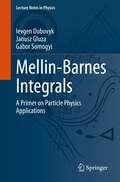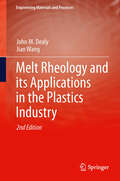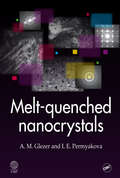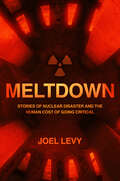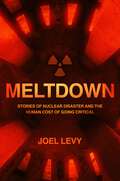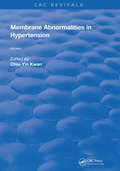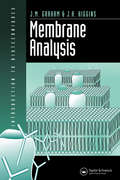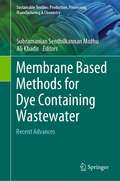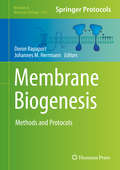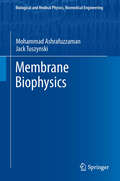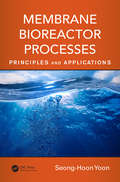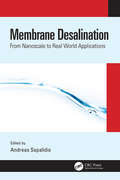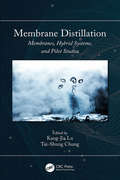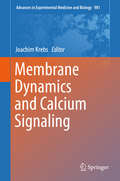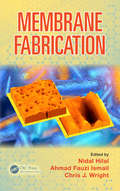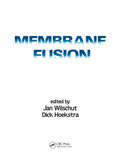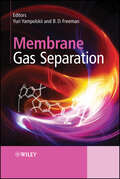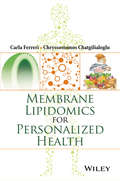- Table View
- List View
Melia and Jo
by Billy AronsonMelia and Jo will be to STEAM what Rosie Revere is to STEM. Melia is scientific and loves to create things in her backyard laboratory, but something is missing. Her inventions just aren&’t quite right. Enter Jo, her new friend with an artistic spirit. When you add the arts to sciences, something magical happens! This whimsically illustrated picture book is the perfect introduction to the benefits of STEAM-focused curriculum.
Mellin-Barnes Integrals: A Primer on Particle Physics Applications (Lecture Notes in Physics #1008)
by Ievgen Dubovyk Janusz Gluza Gábor SomogyiIn this book, the authors discuss the Mellin-Barnes representation of complex multidimensional integrals. Experiments frontiered by the High-Luminosity Large Hadron Collider at CERN and future collider projects demand the development of computational methods to achieve the theoretical precision required by experimental setups. In this regard, performing higher-order calculations in perturbative quantum field theory is of paramount importance. The Mellin-Barnes integrals technique has been successfully applied to the analytic and numerical analysis of integrals connected with virtual and real higher-order perturbative corrections to particle scattering. Easy-to-follow examples with the supplemental online material introduce the reader to the construction and the analytic, approximate, and numeric solution of Mellin-Barnes integrals in Euclidean and Minkowskian kinematic regimes. It also includes an overview of the state-of-the-art software packages for manipulating and evaluating Mellin-Barnes integrals. The book is meant for advanced students and young researchers to master the theoretical background needed to perform perturbative quantum field theory calculations.
Melodías de otros lugares: El tejedor del tiempo - Libro 1
by Cédric FrantzEl equinoccio de primavera se acerca y el invierno está llegando a su fin en Jantival. Kalaen, de once años, lleva una vida ejemplar en su casa familiar. Apasionado por la ciencia y la música, descubre talentos innatos: tiene una percepción inusual del mundo que le rodea. Sus dones extrasensoriales incluso lograron impresionar a su vecino, el anciano alquimista y mago Falchron. Kalaen le tiene un respeto especial y secretamente desea seguir sus pasos. Durante una expedición en el bosque, hace un encuentro inusual y trae a la aldea un objeto misterioso. Con Falchron, intentan entonces desvelar los secretos de esta reliquia que parece datar de tiempos inmemoriales. ¿Cuál es la función de este extraño artefacto? ¿Lograrán descubrirlo? ¿Descubrirán las memorias del tiempo o escucharán el presagio de su fin?
Melt Rheology and its Applications in the Plastics Industry
by Jian Wang John M DealyThis is the second edition of Melt Rheology and its Role in Plastics Processing, although the title has changed to reflect its broadened scope. Advances in the recent years in rheometer technology and polymer science have greatly enhanced the usefulness of rheology in the plastics industry. It is now possible to design polymers having specific molecular structures and to predict the flow properties of melts having those structures. In addition, rheological properties now provide more precise information about molecular structure. This book provides all the information that is needed for the intelligent application of rheology in the development of new polymers, the determination of molecular structure and the correlation of processability with laboratory test data. Theory and equations are limited to what is essential for the use of rheology in the characterization of polymers, the development of new plastics materials and the prediction of plastics processing behavior. The emphasis is on information that will be of direct use to practitioners. Extensive references are provided for those wishing to pursue certain issues in greater depth. While the primary audience is applied polymer scientists and plastics engineers, the book will also be of use to postgraduate students in polymer science and engineering and as a text for a graduate course.
Melt-Quenched Nanocrystals
by A. M. Glezer I. E. PermyakovaMelt quenching-the method of quenching from the liquid state-provides new opportunities for producing advanced materials with a unique combination of properties. In the process of melt quenching, attainment of critical cooling rates can produce specific structural states of the material. Nanocrystalline materials produced by melt quenching are clas
Meltdown: Stories of nuclear disaster and the human cost of going critical
by Joel LevyMeltdown investigates and recreates the dramatic events behind the most notorious nuclear accidents in history, as well as those shrouded in secrecy. Combining human tragedy with intriguing science, each account reveals new aspects of humanity's complex relationship with nuclear power and the ongoing struggle to harness and control it. From the pioneers of Los Alamos who got up close and personal with the cores of atomic bombs, to the hapless engineers in Soviet fuel-processing plants who unwittingly mixed up a disaster in a bucket, and from the terrifying impact of a tsunami at Fukushima to the mystery of the recent Russian incident, Meltdown explores the past and future of this extraordinary and potentially lethal source of infinite power.
Meltdown: Stories of nuclear disaster and the human cost of going critical
by Joel LevyMeltdown investigates and recreates the dramatic events behind the most notorious nuclear accidents in history, as well as those shrouded in secrecy. Combining human tragedy with intriguing science, each account reveals new aspects of humanity's complex relationship with nuclear power and the ongoing struggle to harness and control it. From the pioneers of Los Alamos who got up close and personal with the cores of atomic bombs, to the hapless engineers in Soviet fuel-processing plants who unwittingly mixed up a disaster in a bucket, and from the terrifying impact of a tsunami at Fukushima to the mystery of the recent Russian incident, Meltdown explores the past and future of this extraordinary and potentially lethal source of infinite power.
Meltdown: Stories of nuclear disaster and the human cost of going critical
by Joel LevyMeltdown investigates and recreates the dramatic events behind the most notorious nuclear accidents in history, as well as those shrouded in secrecy. Combining human tragedy with intriguing science, each account reveals new aspects of humanity's complex relationship with nuclear power and the ongoing struggle to harness and control it. From the pioneers of Los Alamos who got up close and personal with the cores of atomic bombs, to the hapless engineers in Soviet fuel-processing plants who unwittingly mixed up a disaster in a bucket, and from the terrifying impact of a tsunami at Fukushima to the mystery of the recent Russian incident, Meltdown explores the past and future of this extraordinary and potentially lethal source of infinite power.
Meltdown: Stories of nuclear disaster and the human cost of going critical
by Joel LevyMeltdown investigates and recreates the dramatic events behind the most notorious nuclear accidents in history, as well as those shrouded in secrecy. Combining human tragedy with intriguing science, each account reveals new aspects of humanity's complex relationship with nuclear power and the ongoing struggle to harness and control it. From the pioneers of Los Alamos who got up close and personal with the cores of atomic bombs, to the hapless engineers in Soviet fuel-processing plants who unwittingly mixed up a disaster in a bucket, and from the terrifying impact of a tsunami at Fukushima to the mystery of the recent Russian incident, Meltdown explores the past and future of this extraordinary and potentially lethal source of infinite power.
Melting Away, Pioneer Edition (Explorer Books)
by Glen PhelanNIMAC-sourced textbook <P><P>Learn about why the Earth is heating up and how people can slow the global warming.
Melting Hadrons, Boiling Quarks - From Hagedorn Temperature to Ultra-Relativistic Heavy-Ion Collisions at CERN
by Johann RafelskiThis book shows how the study of multi-hadron production phenomena in the years after the founding of CERN culminated in Hagedorn's pioneering idea of limiting temperature, leading on to the discovery of the quark-gluon plasma -- announced, in February 2000 at CERN. Following the foreword by Herwig Schopper -- the Director General (1981-1988) of CERN at the key historical juncture -- the first part is a tribute to Rolf Hagedorn (1919-2003) and includes contributions by contemporary friends and colleagues, and those who were most touched by Hagedorn: Tamás Biró, Igor Dremin, Torleif Ericson, Marek Gadzicki, Mark Gorenstein, Hans Gutbrod, Maurice Jacob, István Montvay, Berndt Müller, Grazyna Odyniec, Emanuele Quercigh, Krzysztof Redlich, Helmut Satz, Luigi Sertorio, Ludwik Turko, and Gabriele Veneziano. The second and third parts retrace 20 years of developments that after discovery of the Hagedorn temperature in 1964 led to its recognition as the melting point of hadrons into boiling quarks, and to the rise of the experimental relativistic heavy ion collision program. These parts contain previously unpublished material authored by Hagedorn and Rafelski: conference retrospectives, research notes, workshop reports, in some instances abbreviated to avoid duplication of material, and rounded off with the editor's explanatory notes. About the editor: Johann Rafelski is a theoretical physicist working at The University of Arizona in Tucson, USA. Bor n in 1950 in Krakow, Poland, he received his Ph. D. with Walter Greiner in Frankfurt, Germany in 1973. Rafelski arrived at CERN in 1977, where in a joint effort with Hagedorn he contributed greatly to the establishment of the relativistic heavy ion collision, and quark-gluon plasma research fields. Moving on, with stops in Frankfurt and Cape Town, to Arizona, he invented and developed the strangeness quark flavor as the signature of quark-gluon plasma.
Membrane Abnormalities In Hypertension (Routledge Revivals #1)
by Chiu-Yin KwanFirst Published in 1989, this two-volume set offers a full insight into membrane abnormalities during a state of hypertension. Carefully compiled and filled with diagrams, references and information this set is recommended for students of medicine and other professionals in their respective fields.
Membrane Analysis
by Dr John Graham Joan HigginsMembrane Analysis provides a comprehensive review of laboratory methods for membrane study, with an emphasis on isolating membranes, analysing their composition and architecture, and investigating membrane function.
Membrane Based Methods for Dye Containing Wastewater: Recent Advances (Sustainable Textiles: Production, Processing, Manufacturing & Chemistry)
by Subramanian Senthilkannan Muthu Ali KhadirThis book highlights recent findings of membrane - based dye removal methods along with the application of photocatalytic, nanofiltration and ultrafiltration membrane including membrane – based fibers, metal-organic frameworks, polyethersulfone, ceramic, etc. Among water and wastewater pollutants, dyes have been normally observed and detected in various aquatic solutions, including rivers and lakes. Aesthetic pollution, toxicity, persistent, and carcinogenicity are some of the adverse effects of dyes entering the ecosystem. Although dyes have brought a colourful world, their presence in the environment are responsible for adverse effects on the planet. Diverse physical, chemical and biological methods are available to treat dye contaminated water. This book presents membrane separation technology that has been developed in the past decade to treat different wastewaters, and owning to its effective performance, has garnered the attention of academia and industry alike.
Membrane Biogenesis: Methods and Protocols
by Johannes M. Herrmann Doron RapaportMembrane proteins and membrane lipids form complex interactive systems that are highly dynamic and able to be studied only by combinations of different in vivo and in vitro techniques. In Membrane Biogenesis: Methods and Protocols, experts in the field present a broad collection of methods to study the biogenesis and function of cellular membranes. Beginning with how membrane lipids or membrane proteins can be studied, this detailed volume continues with sections covering different procedures to investigate the interaction of membrane proteins among each other or with membrane lipids, methods to study the biogenesis of membrane proteins and the dynamics of organelles, as well as protocols for the analyses of the functions or complex organization of membrane proteins. Written in the highly successful Methods in Molecular BiologyTM series format, chapters include introductions to their respective topics, lists of materials and reagents, step-by-step, readily reproducible laboratory protocols, and tips on troubleshooting and avoiding known pitfalls. Extensive and easily applicable, Membrane Biogenesis: Methods and Protocols provides readers with a comprehensive but still concise collection including both basic protocols of rather general application and more specialized methods for specific and novel techniques.
Membrane Biophysics
by Jack A. Tuszynski Mohammad AshrafuzzamanPhysics, mathematics and chemistry all play a vital role in understanding the true nature and functioning of biological membranes, key elements of living processes. Besides simple spectroscopic observations and electrical measurements of membranes we address in this book the phenomena of coexistence and independent existence of different membrane components using various theoretical approaches. This treatment will be helpful for readers who want to understand biological processes by applying both simple observations and fundamental scientific analysis. It provides a deep understanding of the causes and effects of processes inside membranes, and will thus eventually open new doors for high-level pharmaceutical approaches towards fighting membrane- and cell-related diseases.
Membrane Bioreactor Processes: Principles and Applications (Advances in Water and Wastewater Transport and Treatment)
by Seong-Hoon YoonGrasp the Essential Principles of Membrane Bioreactor ProcessesEvolved from the conventional activated sludge (CAS) process, membrane bioreactor (MBR) processes have become the next-generation solution for municipal and industrial wastewater treatment and recycle. Membrane Bioreactor Processes: Principles and Applications explores nearly all the th
Membrane Desalination: From Nanoscale to Real World Applications
by Andreas SapalidisThis book aims to provide details about membrane desalination processes, starting from basic concepts leading to real world implementation. Chapters cover novel research topics such as biomimetic and nanocomposite membranes, nanostructured fillers for mixed matrix membranes, advanced characterization techniques and molecular modeling. Additionally, engineering and economical aspects of desalination as well as the exploitation of green energy sources are thoroughly presented. This books targets bridging the gap between the everyday research laboratory practices with practical application demands, so that the readers gain a global perspective of all desalination challenges.
Membrane Distillation: Membranes, Hybrid Systems and Pilot Studies
by Kang-Jia Lu Tai-Shung ChungThis book aims to elaborate the basics and recent advances of membrane distillation (MD) as the same shows promise for seawater desalination and wastewater treatment. Starting with fundamentals of MD processes, including the heat and mass transfer analysis, energy evaluation and mathematical modelling, text includes engineering and molecular design of MD membranes. Various types of hybrid systems, including freeze desalination (FD)-MD, MD-crystallization (MDC), pressure retarded osmosis (PRO)-MD and forward osmosis (FO)-MD, will be discussed in this book. Further, it summarizes the future of MD from both industrial and academic perspectives along with energy sources and economic analysis.
Membrane Dynamics and Calcium Signaling (Advances In Experimental Medicine And Biology #981)
by Joachim KrebsThis book describes the newest discoveries on calcium signaling happening at the cellular and intracellular membranes, often exerted in so called microdomains. Calcium entry and release, its interaction with proteins and resulting events on proteins and organelles are comprehensively depicted by leading experts in the field. Knowledge about details of these highly dynamic processes rapidly increased in recent years, the book therefore provides a timely summary on the processes of calcium signaling and related membrane dynamics; it is aimed at students and researchers in biochemistry and cell biology.
Membrane Fabrication
by Ahmad Fauzi Ismail Nidal Hilal Chris J. WrightMembranes play a crucial role in ensuring the optimum use and recovery of materials in manufacturing. In the process industries, they are required for efficient production and minimization of environmental impact. They are also essential for the efficient production of clean water, a significant global issue. Membrane Fabrication brings together ex
Membrane Fusion
by Jan WilschutThis balanced volume provides a broad and coherent overview of recent progress in membrane fusion research—highlighting an interdisciplinary treatment of the subject from the fields of biophysics, biochemistry, cell biology, virology, and biotechnology—in a single volume., Featuring easy-access sections on the general properties of membranes and applications of membrane fusion techniques, this valuable sourcebook outlines membrane structure, lipid polymorphism, and intermembrane forces ... covers membrane fusion in model systems ... presents the fusogenic properties of enveloped viruses ... discusses the fusion and flow of intracellular membranes and cell-cell fusion occurring during fertilization and myogenesis ... offers applications of membrane fusion techniques in cell-biological research and biotechnology ... and more. Supplying a comprehensive view of this exciting topic, Membrane Fusion is a working resource for molecular, cell, and membrane biologists; biophysicists; biochemists; virologists; biotechnologists; microbiologists; immunologists; physiologists; and graduate and medical school students in biophysics, biochemistry, physiology, virology, cell biology, and biotechnology.
Membrane Gas Separation
by Benny Freeman Yuri YampolskiiGas separation membranes offer a number of benefits over other separation technologies, and they play an increasingly important role in reducing the environmental impacts and costs of many industrial processes.This book describes recent and emerging results in membrane gas separation, including highlights of nanoscience and technology, novel polymeric and inorganic membrane materials, new membrane approaches to solve environmental problems e.g. greenhouse gases, aspects of membrane engineering, and recent achievements in industrial gas separation. It includes:Hyperbranched polyimides, amorphous glassy polymers and perfluorinated copolymersNanocomposite (mixed matrix) membranesPolymeric magnetic membranesSequestration of CO2 to reduce global warmingIndustrial applications of gas separationDeveloped from sessions of the most recent International Congress on Membranes and Membrane Processes, Membrane Gas Separation gives a snapshot of the current situation, and presents both fundamental results and applied achievements.
Membrane Hydration
by E. Anibal DisalvoThis book is about the importance of water in determining the structure, stability and responsive behavior of biological membranes. Water confers to lipid membranes unique features in terms of surface and mechanical properties. The analysis of the hydration forces, plasticiser effects, controlled hydration, formation of microdomains of confined water suggests that water is an active constituent in a water-lipid system. The chapters describe water organization at the lipid membrane-water interphase, the water penetration, the long range water structure in the presence of lipid membranes by means of X-ray and neutron scattering, general polarization, fluorescent probes, ATR-FTIR and near infrared spectroscopies, piezo electric methods, computer simulation and surface thermodynamics. Permeation, percolation, osmotic stress, polarization, protrusion, sorption, hydrophobicity, density fluctuations are treated in detail in self-assembled bilayers. Studies in lipid monolayers show the correlation of surface pressure with water activity and its role in peptide and enzyme interactions. The book concludes with a discussion on anhydrobiosis and the effect of water replacement in microdomains and its consequence for cell function. New definitions of lipid/water interphases consider water not only as a structural-making solvent but as a mediator in signalling metabolic activity, modulating protein insertion and enzymatic activity, triggering oscillatory reactions and functioning of membrane bound receptors. Since these effects occur at the molecular level, membrane hydration appears fundamental to understand the behavior of nano systems and confined environments mimicking biological systems. These insights in structural, thermodynamical and mechanical water properties give a base for new paradigms in membrane structure and function for those interested in biophysics, physical chemistry, biology, bio and nano medicine, biochemistry, biotechnology and nano sciences searching for biotechnological inputs in human health, food industry, plant growing and energy conversion.
Membrane Lipidomics for Personalized Health
by Carla Ferreri Chryssostomos ChatgilialogluLipidomics is an important aspect of personalized medicine in relation to nutrition and metabolism. This approach has become important due to the substantial presence of nutraceuticals in the market, since it gives personalized criteria on how to choose the right nutraceutical strategy for both prevention and for quality of life. This multi-disciplinary textbook uses a simple and practical approach to provide a comprehensive overview of lipidomics and their connection with health and nutrition. The text is divided into two parts: - Part 1 outlines the basics of lipidomics and focuses on the biochemical and nutritional aspects with descriptions of the analytical methods employed for the examination of cell membrane fatty acid composition. - Part 2 familiarizes the reader with the use of membrane lipidomic diagnostics in practical health care, using health conditions as examples to introduce the concept of lipidomic profiles in different physiological and pathological situations including prevention. Through the various properties of membrane lipidomics, readers will be able to combine the molecular status of the cell membrane with the evaluation of the subject for personalized nutritional and nutraceutical strategies. Membrane Lipidomics for Personalized Health will be beneficial to biologists, biochemists and medical researchers, as well as health care professionals, pharmacists, and nutritionists seeking in-depth information on the topic.

